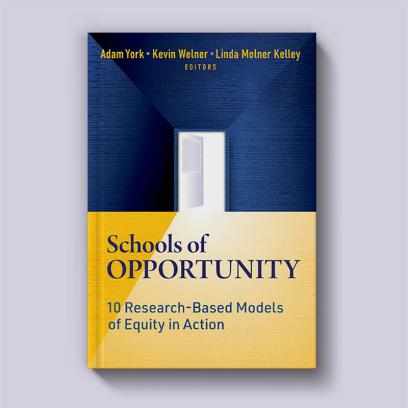The National Education Policy Center’s Schools of Opportunity project highlights public high schools that address societal inequities with research-based practices. To become a School of Opportunity (SOO), schools are evaluated on 10 criteria that include an inclusive school climate, formative assessment and project-based learning, culturally relevant curriculum, supports for students’ mental and physical health, and authentic parent and community engagement.
Schools of Opportunity: 10 Research-Based Models of Equity in Action, edited by Adam York, Kevin Welner, and Linda Molner Kelley, celebrates SOO-recognized schools. Each chapter, coauthored by a leader of a recognized SOO, details reform practices aligned with specific SOO criteria that other schools can emulate. Below is a small sample of the practices profiled.
Broaden and Enrich Learning Opportunities, with Particular Attention to Reducing Disparities in Learning Created by Tracking and Ability Grouping (Criterion 1)
South Side High School (Long Island, New York) eliminated ability grouping and low-track classes to help close the achievement gap between students of diverse ethnicities, economic backgrounds, and academic preparation. International Baccalaureate (IB) and Advanced Placement courses are open to all students, with extra help periods and support classes available. The general education curriculum challenges yet supports all students, including those in special education, who are integrated into general education with support staff and classes, as well as close monitoring. And administrators annually balance enrollment in general education to ensure all courses reflect the school’s demographics. As a result, IB participation increased from 30 percent to over 80 percent. The 2019 four-year graduation rate was 100 percent, and 90 percent of graduates earned a New York State Regents diploma with Advanced Designation—nearly three times the statewide average.
Use a Variety of Assessments Designed to Respond to Student Needs (Criterion 4)
Fannie Lou Hamer Freedom High School (FLHFHS; the Bronx, New York) integrates performance-based portfolio assessment with instruction focused on real-world, inquiry-based learning. Unlike traditional high schools, FLHFHS teachers work closely with just 60 students—in small groups with block scheduling—for two years at a time, first as content instructors, then as advisers. Students take ownership of their learning through community activism and college- and career-relevant internships. Students work with teachers to present and defend their work orally, thinking critically about their learning in each subject area. Through this model, FLHFHS’s four-year graduation rate and the number of graduates considered college ready are significantly higher than comparison high schools.
Provide Students with Additional Needed Services and Supports (Criterion 7); Enact a Challenging and Supported Culturally Relevant Curriculum (Criterion 8)
Dr. Martin Luther King, Jr. Early College’s (DMLK; Denver, Colorado) holistic approach to student learning prioritizes wellness through a Whole Child Team that includes mental health counselors, social workers, a school psychologist, a trauma specialist, a school nurse, and a health technician. Additionally, all teachers are trained to identify signs that students are struggling, and DMLK offers a Strengthening Families program for those experiencing trauma. DMLK students are also agents in their own healing. They campaigned for and won a school board policy requiring that the curriculum promote antiracism and asset-based truths about historically marginalized communities. These initiatives have led to significant increases in the number of students who enjoy going to school and feel safe at school.

